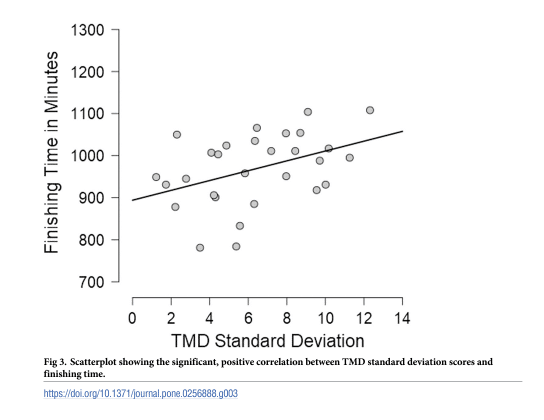
How Mood Variability Affects Ultramarathon Performance
By Jason Koop,
Head Coach of CTS Ultrarunning
The scene at the Twin Lakes aid station during the Leadville Trail 100 is interesting. The small town serves as the aid station at Mile 40 (outbound) and again at Mile 60 (inbound). It’s equal parts haven for tired athletes and late night rager for the crews. For some runners, the infamous Hope Pass double crossing can take 8-9 hours. Crews have lots of time to enjoy the festive atmosphere, thin mountain air, and some of Colorado’s other recreational activities. The aid station slowly morphs from well-intentioned resupply point to something resembling a college residence hall on a Friday night.
Regardless of the level of debauchery from the town’s temporary residents, the one constant is a stark mismatch of energy levels between the runners and the crowd. Runners come into the aid station in all states of emotion. Some are tired, others relieved. Some are amped and others more subdued. The unaware (yet well intended) crew members take on the energy of those around them. There’s a party corner, complete with beer bongs and grateful dead music. The contender’s area is usually at the front or back of the aid station. And there are areas that attract the newbies and veterans alike.
Runners enter not knowing what to expect. At Mile 40, they have no idea where their crew will be or who’s will be around them. And no one knows if they will be offered a shot of Fireball whiskey as they exit the aid station. It’s a lot of fun, but it can be a bit overwhelming. More notably, it is a stark contrast to the serene environment of aspen groves and high alpine lakes that they were recently running through (unless their soft flasks were previously filled with Fireball…).
Mood Variability Research
Year after year, this experience made me wonder: “Is there a cost to the emotional roller coaster athletes sometimes experience during races?” Well, shortly after the 2021 Leadville 100, a novel paper in PLOS One arrived in my inbox. It was aptly titled, “Reduced mood variability is associated with enhanced performance during ultrarunning.”
The paper, authored by Paul Burgum and Daniel Smith in Durham University’s Department of Psychology, used a survey called the BRUMS Mood Scale to ascertain ultramarathon runners’ different subjective levels of mood before and during a 100k race. The survey uses subscales of anger, confusion, depression, fatigue, tension, and rigor to determine an overall ‘mood score’ called the Total Mood Disturbance (TMD). Participants’ scores were calculated a week before and 30-90 minutes before the start, at 33.5k, 66k, and at the finish.
Unsurprisingly (at least to me), athletes who exhibited less deviation in TMD during the race ran faster (see figure below). Literally, if mood was more stable throughout the course of an ultramarathon, performance was better.
This finding aligns with similar research, like this 2019 study, in which athletes performed a 80.5k treadmill time trial. In that study, they measured TMD, emotional intelligence and cortisol levels.
What does this all actually mean?
Sometimes you have to look beyond the ‘no duh’ findings to find the practical implementation points. This is one such instance. It’s easy to say, “Well of course, if my mood is more stable during the race I will perform better.” But how do you use that knowledge to your advantage as an athlete? Let’s look at some instances where you can unintentionally alter your mood state during a race, for the worse:
Getting excessively pumped up pre-race.
I get it, everyone has an idealistic view of their pre-race routine. It’s probably some combination of listening to the Rocky theme song and re-watching your favorite David Goggins Instagram clip. But honestly, whatever adrenaline rush you get is likely unsustainable over the course of any endurance event. That pre-race excitation is followed by hours of low intensity running. Then, intermittently sprinkle in the party atmosphere of aid stations. The combination is bound to create high mood variability. You can remove one component of this by avoiding excessive pre-race excitation. Be happy and full of anticipation, but you probably don’t need to add to it.
Listening to music as you race.
For whatever reason, when I suggest runners shouldn’t listen to music during training and racing, people get offended. Like, to the same level as if I’ve insulted their dietary or political choices. (The reason I can lump those two together is another issue in and of itself.) However, given the aforementioned research on mood disturbance, as well as arguments I’ve made in previous articles, if you choose to listen to music, at least use it in a purposeful way: to course correct any mood disturbances you might encounter during a race.
► Free Ultrarunning Training Assessment Quiz
Take our free 2-minute quiz to discover how effective your training is and get recommendations for how you can improve.
Have your crew subtly match your mood.
This gets tricky. Crews have good intentions. Many times, their well-intended efforts result in an overabundance of positivity all the time, every time, day and night. Often, there’s a severe mismatch between this excessive enthusiasm and the runner’s emotional state. That discrepancy can be a recipe for large mood disturbances that have unintended negative consequences for the runner. For instance, consider the runners coming into the Twin Lakes aid station mentioned earlier.
Of course, if you are on a runner’s crew this doesn’t mean you should perpetuate your runner’s pity party. Rather, it means that when faced with that situation, gradually course correct it. As my colleague and sports psychologist Justin Ross is fond of saying, “When you are in a hole, you can always work back (not artificially force or speed) to optimism.”
It’s natural and expected that you’ll go through highs and lows during an ultra. By knowing how differences in your mood can affect performance, you can leverage your crew, attitude and fellow competitors to reduce this variability for better performance.
Enjoying This Article? Get More Free Running Training Tips
Get our coaches' best training advice, delivered straight to your inbox weekly.
References
Burgum P, Smith DT. Reduced mood variability is associated with enhanced performance during ultrarunnning. PLoS One. 2021 Sep 16;16(9):e0256888. doi: 10.1371/journal.pone.0256888. PMID: 34529656; PMCID: PMC8445466.
Howe CCF, Pummell E, Pang S, Spendiff O, Moir HJ. Emotional intelligence and mood states impact on the stress response to a treadmill ultramarathon. J Sci Med Sport. 2019 Jul;22(7):763-768. doi: 10.1016/j.jsams.2019.02.008. Epub 2019 Mar 12. PMID: 30922550.



Comments 3
A poignant article Koop. With a significant amount of experience I totally agree. Having lined up on many starting lines I’m always surprised at the over abundance of fairly high energy and ampedness! I’ve learned the hard way that saving all the energy to be metered out across a very big day is a much more effective.
For newer athletes especially it is incredibly important to consider this (and discuss it at length) with your crew and who’s on it.
Twin lakes especially is always one of those aid stations of dread coming in as the beautiful serenity we’ve all been running though (or riding though) is shattered. It’s an important tactic in an athletes strategy to expect this and be mentally prepared for it.
Thanks for the writing 👍🙏
Pingback: Ultramarathon Daily News | Fri, Feb 11 - Ultrarunnerpodcast.com
Interesting.
I strongly believe there is a point here. But let’s not forget potential need for causality. A more experienced runner might be more emotionally stable (less pumped up, more accustomed to the lows etc), AND run faster. And vice versa.
(Somewhere I read that even pace predicts faster race times. Could be same potential causality.)